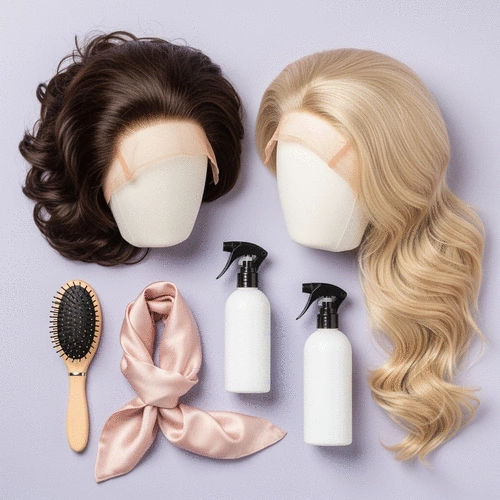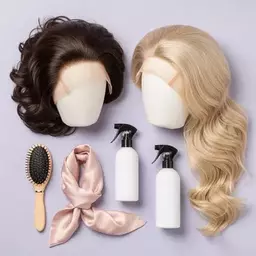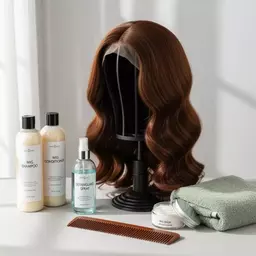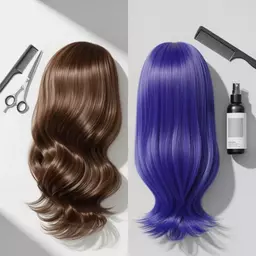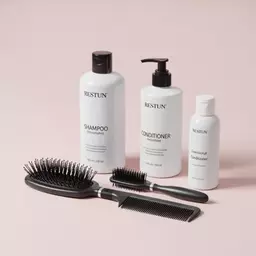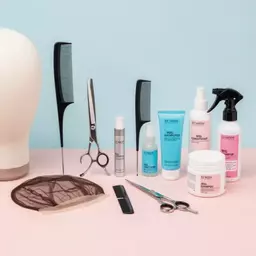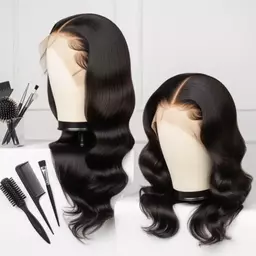Are you ready to transform your wig care routine and make your favorite styles last longer? Understanding the essentials of wig maintenance can elevate your experience and boost your confidence!
What You Will Learn
- Differentiate between human hair and synthetic wigs to choose the right type for your lifestyle.
- Recognize key quality indicators in wigs, including material, construction, and weight for better longevity.
- Understand the significance of proper wig care in maintaining appearance, comfort, and extending lifespan.
- Implement a consistent wig care routine that includes washing, storing, and styling to keep your wig looking its best.
Wig Types and Care Considerations
Understanding the distinctions between human hair and synthetic wigs, along with their respective care requirements, is crucial for maintaining their longevity and appearance. The visual below highlights key characteristics and care considerations for each type. For a deeper dive into choosing the right wig for you, explore our guide on human hair vs. synthetic wigs.
Human Hair Wigs
- • Versatility: Can be styled, dyed, and treated like natural hair.
- • Maintenance: Requires more regular and delicate care.
- • Lifespan: Longer with proper, consistent care.
Synthetic Wigs
- • Versatility: Holds style well, cannot withstand heat styling.
- • Maintenance: Easier to maintain, often more affordable.
- • Lifespan: Shorter than human hair, even with good care.
Essential Insights into Wig Care for 2025
Caring for your wig properly can really make a difference in how long it lasts and how great it looks! At Ahead In Wigs, I believe understanding the basics of wig care is essential for everyone, whether you’re a newbie or a seasoned pro. Let’s dive into some critical insights that will help you maintain your wig’s beauty and longevity.
Understanding the Types of Wigs: Human vs. Synthetic
When it comes to wigs, you’ll find two main types: human hair and synthetic wigs. Each has its unique characteristics, benefits, and care requirements.
- Human Hair Wigs: These wigs offer the most versatility. You can style, dye, and treat them just like your natural hair! However, they require more maintenance.
- Synthetic Wigs: These come in a variety of styles and colors, holding their shape well. They’re easier to maintain and often more affordable, but they can’t withstand heat styling.
Knowing the differences can help you choose the right wig for your lifestyle and preferences. Have you thought about which type matches your needs best? For detailed information on wig care for both synthetic and human hair, check out our dedicated guide.
Wig Quality and Lifespan: What to Look For
Not all wigs are created equal! The quality of a wig affects its lifespan and how manageable it is. Here are a few key indicators to consider:
- Material: High-quality human hair or premium synthetic fibers.
- Construction: A good cap construction ensures a natural look and comfort.
- Weight: A well-made wig should feel lightweight yet sturdy.
These factors play a significant role in how long your wig will last and how well it will hold up against daily wear. Always check these details before making a purchase!
The Importance of Wig Care: Why It Matters
Proper wig care isn’t just about keeping it clean; it’s about extending its lifespan and maintaining that fresh, natural look. Here’s why you should prioritize wig care:
- Longevity: Regular maintenance can significantly increase your wig's lifespan.
- Appearance: A well-cared-for wig looks more vibrant and natural.
- Comfort: Proper care can help maintain comfort during wear.
Taking the time to care for your wig is an investment in your style. What steps are you currently taking to keep your wig looking fabulous?
Step-by-Step Wig Care Techniques
Now that we’ve covered the basics, it’s time to delve into some practical techniques for effective wig care. These steps will help you enjoy your wig for years to come!
We Want to Hear From You!
What aspect of wig care do you find most challenging? Share your thoughts below:
Summarizing Key Wig Care Takeaways
As we wrap up our guide on wig care, let's take a moment to highlight the essential points we've explored together. Proper maintenance is vital for both human and synthetic wigs, ensuring they remain vibrant and stylish for longer. Remember, understanding the differences between wig types can significantly impact your care strategies.
Here’s a quick recap of the crucial aspects to remember:
- Wig Type Matters: Human hair wigs offer versatility while synthetic wigs are low-maintenance but come with their own unique care requirements.
- Quality Counts: Investing in high-quality wigs means they will last longer and look better over time.
- Regular Care: A consistent care routine, including washing, storing, and styling, is essential for maintaining your wig’s appearance.
Taking these points to heart will help you navigate the world of wig care with confidence! Remember, the right techniques can enhance not just the lifespan of your wig but also your overall experience wearing it.
Get Started with Your Wig Care Routine Today
Now that you have all the tools and tips at your disposal, it's time to dive into your personalized wig care routine! I encourage you to implement the techniques we've discussed, tailoring them to suit your specific needs and wig type. Creating a routine will not only enhance the longevity of your wig but also elevate your overall styling experience. For more in-depth guidance on establishing a consistent care regimen, check out our article on wig care routine for longevity.
Don’t forget to share your own wig care experiences or any questions you might have in the comments! At Ahead In Wigs, we love hearing from our community and are here to support you on your journey to beautiful, confident hair.
Frequently Asked Questions About Wig Care
Q: What are the main differences between human hair and synthetic wigs?
A: Human hair wigs offer versatility, allowing for styling, dyeing, and treating like natural hair, but require more maintenance and are generally more expensive. Synthetic wigs hold their style well, are easier to maintain, and are more affordable, but cannot withstand heat styling.
Q: How can I tell the quality of a wig before purchasing?
A: Key indicators of wig quality include the material (high-quality human hair or premium synthetic fibers), cap construction (for a natural look and comfort), and weight (should feel lightweight yet sturdy). These factors contribute to the wig's lifespan and manageability.
Q: Why is proper wig care important?
A: Proper wig care is crucial for extending its lifespan, maintaining its vibrant and natural appearance, and ensuring comfort during wear. A consistent care routine helps protect your investment and keeps your wig looking its best.
Q: What are the essential steps in a wig care routine?
A: An essential wig care routine includes regular washing, proper storing, and appropriate styling techniques tailored to your wig type. Adhering to these steps will help preserve the wig's condition and appearance.
Q: Can I use regular hair products on my wig?
A: For human hair wigs, you can use products designed for treated hair, but it's often best to use wig-specific products to avoid damage. For synthetic wigs, always use products specifically formulated for synthetic hair, as regular hair products can cause damage or residue buildup.
Recap of Key Points
Here is a quick recap of the important points discussed in the article:
- Wig Type Matters: Human hair wigs offer versatility while synthetic wigs are low-maintenance but come with their own unique care requirements.
- Quality Counts: Investing in high-quality wigs means they will last longer and look better over time.
- Regular Care: A consistent care routine, including washing, storing, and styling, is essential for maintaining your wig’s appearance.

